Remote Sensing Identification and the Spatiotemporal Variation of Drought Characteristics in Inner Mongolia, China
Abstract
:1. Introduction
2. Materials and Methods
2.1. Study Area
2.2. Data Sources and Preprocessing
2.2.1. Remote Sensing Data
2.2.2. Vegetation Cover Data
2.2.3. Meteorological Data
2.3. Methodology
2.3.1. DSI
2.3.2. Sen + Mann–Kendall Trend Estimation
2.3.3. Weight Transfer Model
2.3.4. Correlation Analysis
2.3.5. Geographic Probe Model
3. Results
3.1. Spatial Distribution Characteristics and Drought Trends
3.2. Effect of Different Vegetation Types on DSI
3.3. Area Change in Drought Classification
3.4. Drought Center of Gravity Shift Distribution Characteristics
3.5. Drought Driving Force Analysis
4. Discussion
5. Conclusions
- (1)
- From 2001 to 2020, the spatial distribution of the DSI in Inner Mongolia was generally characterized by a dry west and a wet east. In addition, the changes in the DSI showed an upward trend.
- (2)
- Inner Mongolia’s wet, normal and dry centers of gravity showed a migration trend from northeast to southwest, and the migration distances were all over 200 km.
- (3)
- Temperature and elevation were the main influences driving the formation of aridification in the study area. In addition, four pairs of temperature and elevation, temperature and slope, temperature and land use, and temperature and rainfall combined to drive the formation of aridification in Inner Mongolia.
Author Contributions
Funding
Data Availability Statement
Acknowledgments
Conflicts of Interest
References
- Cheng, G.; Liu, T.; Wang, S.; Wu, Y.; Zhang, C. Responses to the Impact of Drought on Carbon and Water Use Efficiency in Inner Mongolia. Land 2023, 12, 583. [Google Scholar] [CrossRef]
- Gang, C.; Wang, Z.; Chen, Y.; Yang, Y.; Li, J.; Cheng, J.; Qi, J.; Odeh, I. Drought-induced dynamics of carbon and water use efficiency of global grasslands from 2000 to 2011. Ecol. Indic. 2016, 67, 788–797. [Google Scholar] [CrossRef]
- Yang, S.; Song, S.; Li, F.; Yu, M.; Yu, G.; Zhang, Q.; Cui, H.; Wang, R.; Wu, Y. Vegetation coverage changes driven by a combination of climate change and human activities in Ethiopia, 2003–2018. Ecol. Inform. 2022, 71, 101776. [Google Scholar] [CrossRef]
- Chen, Y.; Yang, J.; Xu, Y.; Zhang, W.; Wang, Y.; Wei, J.; Cheng, W. Remote-Sensing Drought Monitoring in Sichuan Province from 2001 to 2020 Based on MODIS Data. Atmosphere 2022, 13, 1970. [Google Scholar] [CrossRef]
- Liu, C.; Wang, C.; Li, Y.; Wang, Y. Spatiotemporal differentiation and geographic detection mechanism of ecological security in Chongqing, China. Glob. Ecol. Conserv. 2022, 35, e02072. [Google Scholar] [CrossRef]
- He, C.; Shao, H.; Xian, W. Spatiotemporal Variation and Driving Forces Analysis of Eco-System Service Values: A Case Study of Sichuan Province, China. Int. J. Environ. Res. Public Health 2022, 19, 8595. [Google Scholar] [CrossRef] [PubMed]
- Ye, C.; Hu, M.; Lu, L.; Dong, Q.; Gu, M. Spatio-temporal evolution and factor explanatory power analysis of urban resilience in the Yangtze River Economic Belt. Geogr. Sustain. 2022, 3, 299–311. [Google Scholar] [CrossRef]
- Yang, H.; Hu, D.; Xu, H.; Zhong, X. Assessing the spatiotemporal variation of NPP and its response to driving factors in Anhui province, China. Environ. Sci. Pollut. Res. 2020, 27, 14915–14932. [Google Scholar] [CrossRef]
- Liu, X.; Zhu, X.; Pan, Y.; Zhao, A.; Li, Y. Spatiotemporal changes of cold surges in Inner Mongolia between 1960 and 2012. J. Geogr. Sci. 2015, 25, 259–273. [Google Scholar] [CrossRef]
- Pan, N.; Guan, Q.; Wang, Q.; Sun, Y.; Li, H.; Ma, Y. Spatial differentiation and driving mechanisms in ecosystem service value of arid region: A case study in the middle and lower reaches of Shule River Basin, NW China. J. Clean. Prod. 2021, 319, 128718. [Google Scholar] [CrossRef]
- Ji, B.; Qin, Y.; Zhang, T.; Zhou, X.; Yi, G.; Zhang, M.; Li, M. Analyzing Driving Factors of Drought in Growing Season in the Inner Mongolia Based on Geodetector and GWR Models. Remote Sens. 2022, 14, 6007. [Google Scholar]
- Pei, Z.; Fang, S.; Wang, L.; Yang, W. Comparative Analysis of Drought Indicated by the SPI and SPEI at Various Timescales in Inner Mongolia, China. Water 2020, 12, 1925. [Google Scholar] [CrossRef]
- Wang, H.; Yao, F.; Zhu, H.; Zhao, Y. Spatiotemporal variation of vegetation coverage and its response to climate factors and human activities in arid and semi-arid areas: Case study of the Otindag Sandy Land in China. Sustainability 2020, 12, 5214. [Google Scholar]
- Wu, Z.; Xue, W.; Xu, H.; Yan, D.; Wang, H.; Qi, W. Urban Flood Risk Assessment in Zhengzhou, China, Based on a D-Number-Improved Analytic Hierarchy Process and a Self-Organizing Map Algorithm. Remote Sens. 2022, 14, 4777. [Google Scholar] [CrossRef]
- Shi, J.; Shi, P.; Wang, Z.; Wang, L.; Li, Y. Multi-Scenario Simulation and Driving Force Analysis of Ecosystem Service Value in Arid Areas Based on PLUS Model: A Case Study of Jiuquan City, China. Land 2023, 12, 937. [Google Scholar] [CrossRef]
- Wen, Y.; Guo, B.; Zang, W.; Lai, J.; Li, R. Quantitative discrimination of the influences of climate change and human activity on rocky desertification based on a novel feature space model. Open Geosci. 2022, 14, 367–381. [Google Scholar] [CrossRef]
- Chen, K.; Ge, G.; Bao, G.; Bai, L.; Tong, S.; Bao, Y.; Chao, L. Impact of Extreme Climate on the NDVI of Different Steppe Areas in Inner Mongolia, China. Remote Sens. 2022, 14, 1530. [Google Scholar] [CrossRef]
- Zeng, J.; Zhang, R.; Qu, Y.; Bento, V.A.; Zhou, T.; Lin, Y.; Wu, X.; Qi, J.; Shui, W.; Wang, Q. Improving the drought monitoring capability of VHI at the global scale via ensemble indices for various vegetation types from 2001 to 2018. Weather Clim. Extrem. 2022, 35, 100412. [Google Scholar] [CrossRef]
- Pham, H.T.; Awange, J.; Kuhn, M.; Nguyen, B.V.; Bui, L.K. Enhancing crop yield prediction utilizing machine learning on satellite-based vegetation health indices. Sensors 2022, 22, 719. [Google Scholar] [CrossRef]
- Masroor, M.; Sajjad, H.; Rehman, S.; Singh, R.; Rahaman, M.H.; Sahana, M.; Ahmed, R.; Avtar, R. Analysing the relationship between drought and soil erosion using vegetation health index and RUSLE models in Godavari middle sub-basin, India. Geosci. Front. 2022, 13, 101312. [Google Scholar] [CrossRef]
- Abdi, M.J.; Raffar, N.; Zulkafli, Z.; Nurulhuda, K.; Rehan, B.M.; Muharam, F.M.; Khosim, N.A.; Tangang, F. Index-based insurance and hydroclimatic risk management in agriculture: A systematic review of index selection and yield-index modelling methods. Int. J. Disaster Risk Reduct. 2022, 67, 102653. [Google Scholar] [CrossRef]
- Li, W.; Wang, Y.; Yang, J. Cloudy Region Drought Index (CRDI) Based on Long-Time-Series Cloud Optical Thickness (COT) and Vegetation Conditions Index (VCI): A Case Study in Guangdong, South Eastern China. Remote Sens. 2020, 12, 3641. [Google Scholar] [CrossRef]
- Wei, W.; Pang, S.; Wang, X.; Zhou, L.; Xie, B.; Zhou, J.; Li, C. Temperature Vegetation Precipitation Dryness Index (TVPDI)-based dryness-wetness monitoring in China. Remote Sens. Environ. 2020, 248, 111957. [Google Scholar] [CrossRef]
- Shi, S.; Yao, F.; Zhang, J.; Yang, S. Evaluation of temperature vegetation dryness index on drought monitoring over Eurasia. IEEE Access 2020, 8, 30050–30059. [Google Scholar] [CrossRef]
- Zhang, J.; Mu, Q.; Huang, J. Assessing the remotely sensed Drought Severity Index for agricultural drought monitoring and impact analysis in North China. Ecol. Indic. 2016, 63, 296–309. [Google Scholar] [CrossRef]
- Haroon, M.A.; Zhang, J.; Yao, F. Drought monitoring and performance evaluation of MODIS-based drought severity index (DSI) over Pakistan. Nat. Hazards 2016, 84, 1349–1366. [Google Scholar] [CrossRef]
- Carlson, T.N.; Perry, E.M.; Schmugge, T.J. Remote estimation of soil moisture availability and fractional vegetation cover for agricultural fields. Agric. For. Meteorol. 1990, 52, 45–69. [Google Scholar] [CrossRef]
- Zormand, S.; Jafari, R.; Koupaei, S.S. Assessment of PDI, MPDI and TVDI drought indices derived from MODIS Aqua/Terra Level 1B data in natural lands. Nat. Hazards 2017, 86, 757–777. [Google Scholar] [CrossRef]
- Kang, Y.; Guo, E.-L.; Wang, Y.-F.; Bao, Y.-L.; Bao, Y.-H.; Na, R.-M. Application of temperature vegetation dryness index for drought monitoring in Mongolian Plateau. Ying Yong Sheng Tai Xue Bao J. Appl. Ecol. 2021, 32, 2534–2544. [Google Scholar]
- Bhuiyan, C.; Singh, R.P.; Kogan, F.N. Monitoring drought dynamics in the Aravalli region (India) using different indices based on ground and remote sensing data. Int. J. Appl. Earth Obs. Geoinf. 2006, 8, 289–302. [Google Scholar] [CrossRef]
- Jackson, R.D.; Idso, S.B.; Reginato, R.J.; Pinter, P.J., Jr. Canopy temperature as a crop water stress indicator. Water Resour. Res. 1981, 17, 1133–1138. [Google Scholar] [CrossRef]
- Um, M.-J.; Kim, Y.; Park, D. Evaluation and modification of the drought severity index (DSI) in East Asia. Remote Sens. Environ. 2018, 209, 66–76. [Google Scholar] [CrossRef]
- Tong, D.; Bai, Y.; Zhang, S.; Liu, Q.; Yang, J. Applicability of Drought Severity Index(DSI) in Remote Sensing Monitoring of Drought in Shandong Province. Chin. J. Agrometeorol. 2020, 41, 102–112. [Google Scholar]
- Huang, J.; Sun, Z.; Du, M. Spatiotemporal characteristics and determinants of agricultural carbon offset rate in China based on the geographic detector. Environ. Sci. Pollut. Res. 2023, 30, 58142–58155. [Google Scholar] [CrossRef] [PubMed]
- Guo, Y.; Han, L.; Zhang, D.; Sun, G.; Fan, J.; Ren, X. The Factors Affecting the Quality of the Temperature Vegetation Dryness Index (TVDI) and the Spatial–Temporal Variations in Drought from 2011 to 2020 in Regions Affected by Climate Change. Sustainability 2023, 15, 11350. [Google Scholar] [CrossRef]
- Li, J.; Chunyu, X.; Huang, F. Land Use Pattern Changes and the Driving Forces in the Shiyang River Basin from 2000 to 2018. Sustainability 2022, 15, 154. [Google Scholar] [CrossRef]
- Li, P.; Hu, Z.; Liu, Y. Shift in the trend of browning in Southwestern Tibetan Plateau in the past two decades. Agric. For. Meteorol. 2020, 287, 107950. [Google Scholar] [CrossRef]
- Wang, L.; Kotani, A.; Tanaka, T.; Ohta, T. Assessment of drought condition using remotely sensed drought severity index and its correlations with soil moisture product in Inner Mongolia. Theor. Appl. Climatol. 2020, 141, 715–728. [Google Scholar] [CrossRef]
- Vrieling, A.; De Leeuw, J.; Said, M.Y. Length of Growing Period over Africa: Variability and Trends from 30 Years of NDVI Time Series. Remote Sens. 2013, 5, 982–1000. [Google Scholar] [CrossRef]
- Duan, H.; Wang, T.; Xue, X.; Yan, C. Dynamic monitoring of aeolian desertification based on multiple indicators in Horqin Sandy Land, China. Sci. Total Environ. 2019, 650, 2374–2388. [Google Scholar] [CrossRef]
- Li, J.; Wang, J.; Zhang, J.; Liu, C.; He, S.; Liu, L. Growing-season vegetation coverage patterns and driving factors in the China-Myanmar Economic Corridor based on Google Earth Engine and geographic detector. Ecol. Indic. 2022, 136, 108620. [Google Scholar] [CrossRef]
- Bai, Y.; Deng, X.; Cheng, Y.; Hu, Y.; Zhang, L. Exploring regional land use dynamics under shared socioeconomic pathways: A case study in Inner Mongolia, China. Technol. Forecast. Soc. Change 2021, 166, 120606. [Google Scholar] [CrossRef]
- Hao, L.; Li, L.; Zhang, B.; Chen, Y. Research on the coupling and coordinated development of forest economic and ecological environment systems in Heilongjiang Province. Sustain. For. 2022, 5, 28–38. [Google Scholar] [CrossRef]
- Tong, S.; Zhang, J.; Bao, Y.; Wurina; Terigele; Weilisi; Lianxiao. Spatial and temporal variations of vegetation cover and the relationships with climate factors in Inner Mongolia based on GIMMS NDVI3g data. J. Arid Land 2017, 9, 394–407. [Google Scholar] [CrossRef]
- Ma, Z.-C.; Sun, P.; Zhang, Q.; Hu, Y.-Q.; Jiang, W. Characterization and Evaluation of MODIS-Derived Crop Water Stress Index (CWSI) for Monitoring Drought from 2001 to 2017 over Inner Mongolia. Sustainability 2021, 13, 916. [Google Scholar] [CrossRef]
- Gao, J.; Jiang, Y.; Wang, H.; Zuo, L. Identification of dominant factors affecting soil erosion and water yield within ecological red line areas. Remote Sens. 2020, 12, 399. [Google Scholar] [CrossRef]
- Liu, W.; Ma, S.; Feng, K.; Gong, Y.; Liang, L.; Tsubo, M. The Suitability Assessment of Agricultural Drought Monitoring Indices: A Case Study in Inland River Basin. Agronomy 2023, 13, 469. [Google Scholar] [CrossRef]
- Meng, F.; Guo, J.; Guo, Z.; Lee, J.C.K.; Liu, G.; Wang, N. Urban ecological transition: The practice of ecological civilization construction in China. Sci. Total Environ. 2021, 755, 142633. [Google Scholar] [CrossRef]
- Shen, Y.; Ren, Y. Construction and evaluation of a system to measure the coordinated development of the ecological environment and the economy of the construction industry. Environ. Sci. Pollut. Res. 2022, 29, 12648–12660. [Google Scholar] [CrossRef]
- Feng, S.; Liu, X.; Zhao, W.; Yao, Y.; Zhou, A.; Liu, X.; Pereira, P. Key areas of ecological restoration in Inner Mongolia based on ecosystem vulnerability and ecosystem service. Remote Sens. 2022, 14, 2729. [Google Scholar] [CrossRef]
- Zhang, X.; Xu, D.; Wang, Z.; Zhang, Y. Balance of water supply and consumption during ecological restoration in arid regions of Inner Mongolia, China. J. Arid Environ. 2021, 186, 104406. [Google Scholar] [CrossRef]
- Zhang, F.; Nilsson, C.; Xu, Z.; Zhou, G. Evaluation of restoration approaches on the Inner Mongolian Steppe based on criteria of the Society for Ecological Restoration. Land Degrad. Dev. 2020, 31, 285–296. [Google Scholar] [CrossRef]
- Kou, X.; Li, J.; Liu, H.; Li, B.; Yu, X.; Cao, X.; Liu, D.; Wen, L.; Zhuo, Y.; Wang, L. Characteristics of bacterial biodiversity and community structure in non-rhizosphere soils along zonal distribution of plants within littoral wetlands in inner Mongolia, China. Glob. Ecol. Conserv. 2020, 24, e01310. [Google Scholar] [CrossRef]
- Wang, Q.; Liu, X.; Wang, Z.; Zhao, L.; Zhang, Q.-P. Time scale selection and periodicity analysis of grassland drought monitoring index in Inner Mongolia. Glob. Ecol. Conserv. 2022, 36, e02138. [Google Scholar] [CrossRef]
- Yu, D.; Li, Y.; Yin, B.; Wu, N.; Ye, R.; Liu, G. Spatiotemporal variation of net primary productivity and its response to drought in Inner Mongolian desert steppe. Glob. Ecol. Conserv. 2022, 33, e01991. [Google Scholar] [CrossRef]
- Shen, Z.; Zhang, Q.; Singh, V.P.; Sun, P.; Song, C.; Yu, H. Agricultural drought monitoring across Inner Mongolia, China: Model development, spatiotemporal patterns and impacts. J. Hydrol. 2019, 571, 793–804. [Google Scholar] [CrossRef]
- Wei, Y.; Zhu, L.; Chen, Y.; Cao, X.; Yu, H. Spatiotemporal Variations in Drought and Vegetation Response in Inner Mongolia from 1982 to 2019. Remote Sens. 2022, 14, 3803. [Google Scholar] [CrossRef]
- Yan, H.; Wang, S.-Q.; Wang, J.-B.; Lu, H.-Q.; Guo, A.-H.; Zhu, Z.-C.; Myneni, R.B.; Shugart, H.H. Assessing spatiotemporal variation of drought in China and its impact on agriculture during 1982–2011 by using PDSI indices and agriculture drought survey data. J. Geophys. Res. Atmos. 2016, 121, 2283–2298. [Google Scholar] [CrossRef]
- Li, Y.; Strapasson, A.; Rojas, O. Assessment of El Niño and La Niña impacts on China: Enhancing the Early Warning System on Food and Agriculture. Weather Clim. Extrem. 2020, 27, 100208. [Google Scholar] [CrossRef]
- Li, H.; Hou, E.; Deng, J. Spatio-Temporal Differentiation Characteristic and Evolution Process of Meteorological Drought in Northwest China From 1960 to 2018. Front. Earth Sci. 2022, 10, 857953. [Google Scholar] [CrossRef]
- Song, X.; Li, L.; Fu, G.; Li, J.; Zhang, A.; Liu, W.; Zhang, K. Spatial–temporal variations of spring drought based on spring-composite index values for the Songnen Plain, Northeast China. Theor. Appl. Climatol. 2014, 116, 371–384. [Google Scholar] [CrossRef]
- Zhou, L.; Wu, J.; Mo, X.; Zhou, H.; Diao, C.; Wang, Q.; Chen, Y.; Zhang, F. Quantitative and detailed spatiotemporal patterns of drought in China during 2001–2013. Sci. Total Environ. 2017, 589, 136–145. [Google Scholar] [CrossRef]
- Tong, S.; Lai, Q.; Zhang, J.; Bao, Y.; Lusi, A.; Ma, Q.; Li, X.; Zhang, F. Spatiotemporal drought variability on the Mongolian Plateau from 1980–2014 based on the SPEI-PM, intensity analysis and Hurst exponent. Sci. Total Environ. 2018, 615, 1557–1565. [Google Scholar] [CrossRef] [PubMed]
- Tong, S.; Bao, G.; Bao, Y.; Huang, X. Monitoring of long-term vegetation dynamics and responses to droughts of various timescales in Inner Mongolia. Ecosphere 2023, 14, e4415. [Google Scholar] [CrossRef]
- Wang, C.; Chen, J.; Chen, X.; Chen, J. Identification of concealed faults in a grassland area in Inner Mongolia, China, using the temperature vegetation dryness index. J. Earth Sci. 2019, 30, 853–860. [Google Scholar] [CrossRef]
- Du, W.; Guo, E.; Wang, A.; Tong, Z.; Liu, X.; Zhang, J.; Guna, A. Spatiotemporal variation in precipitation concentration and its potential relationship with drought under different scenarios in Inner Mongolia, China. Int. J. Climatol. 2022, 42, 7648–7667. [Google Scholar] [CrossRef]
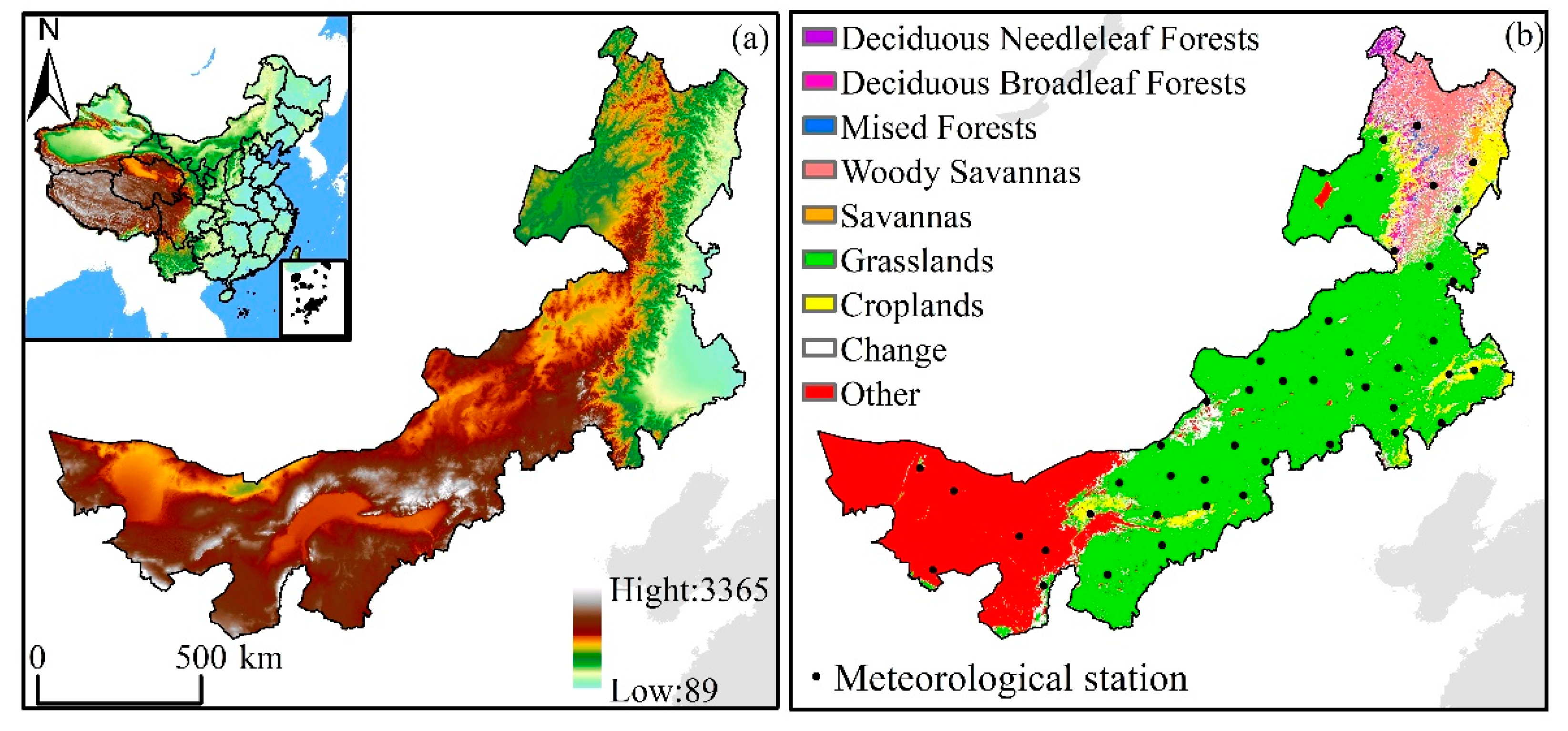
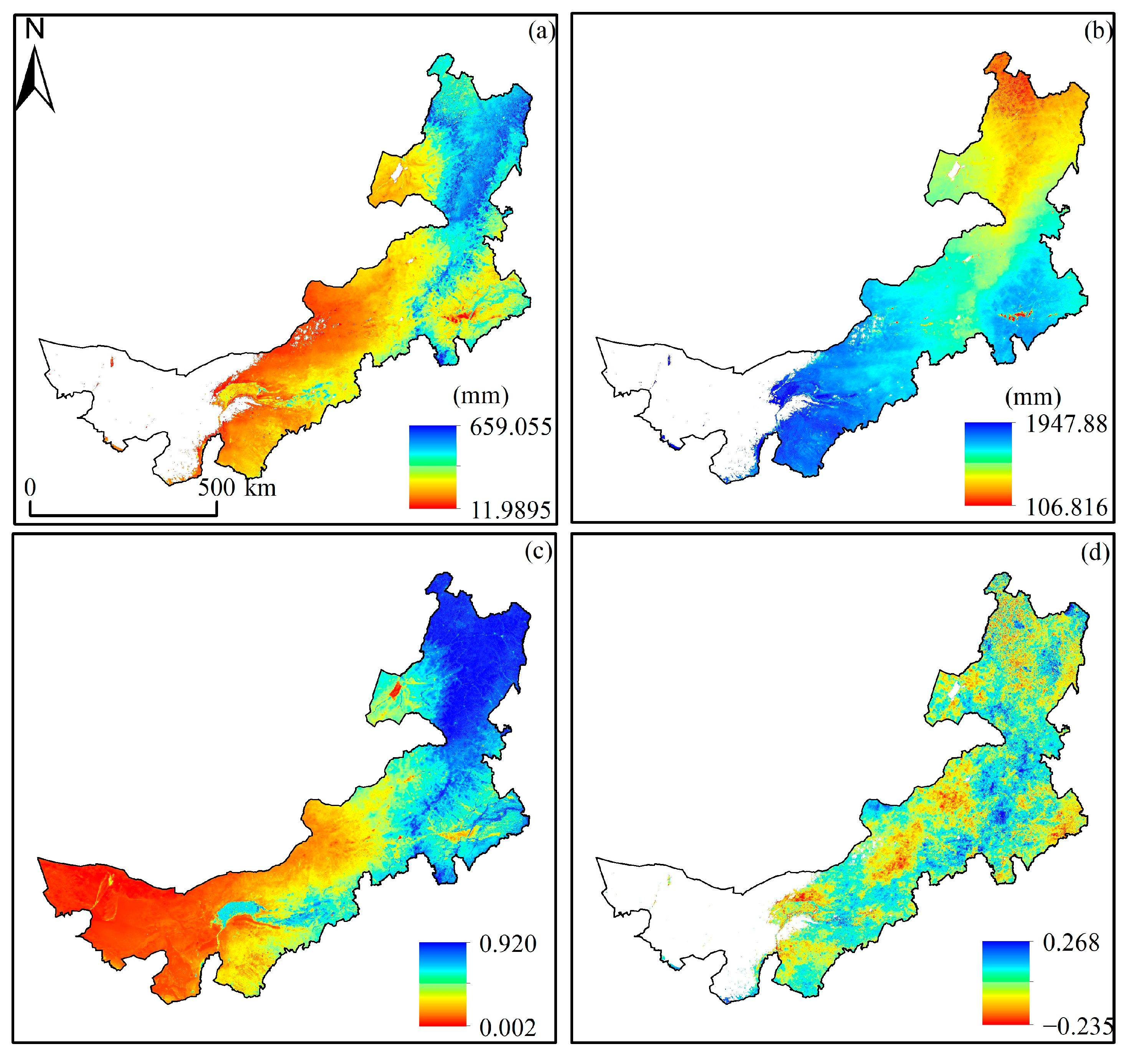
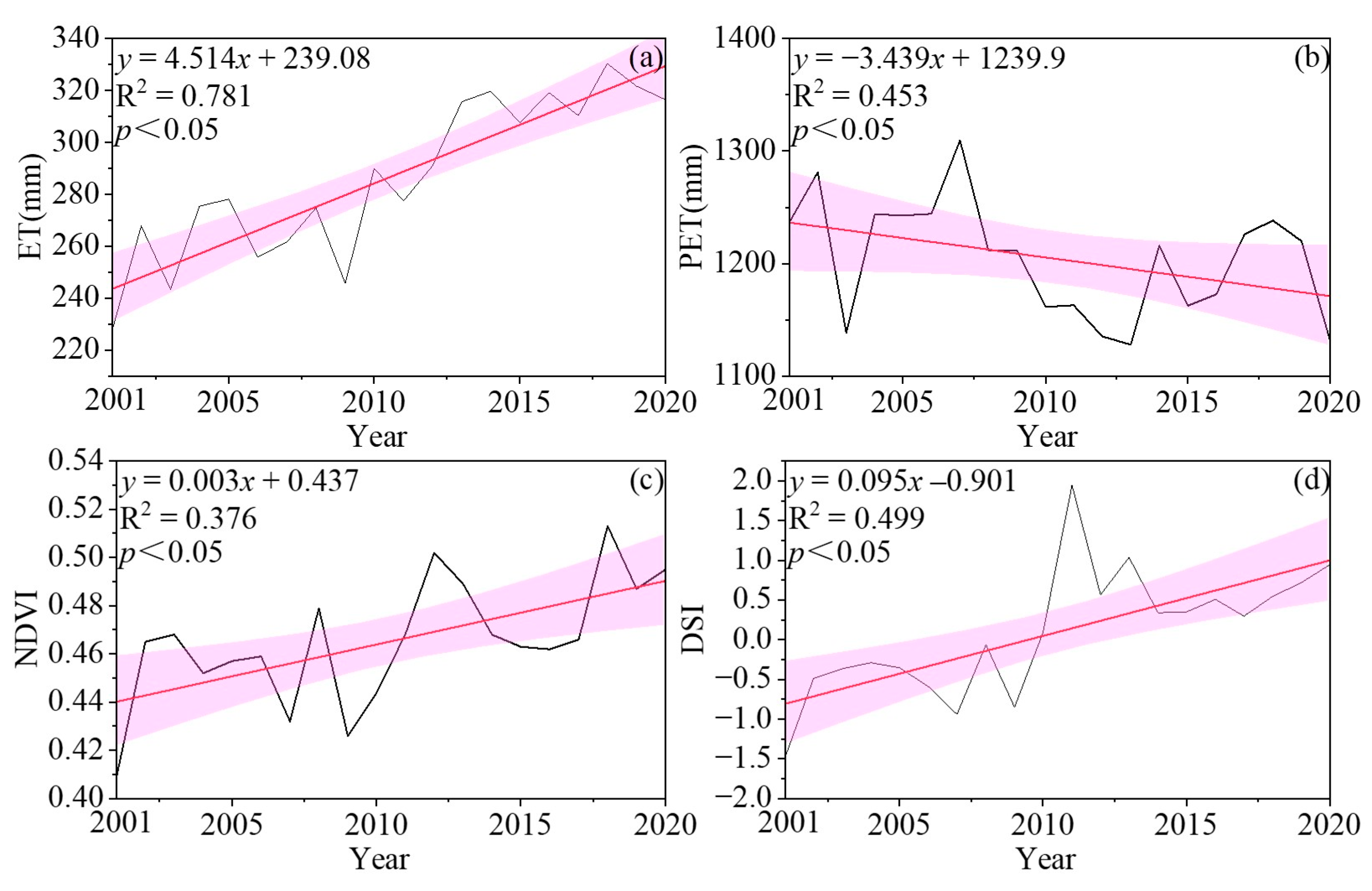

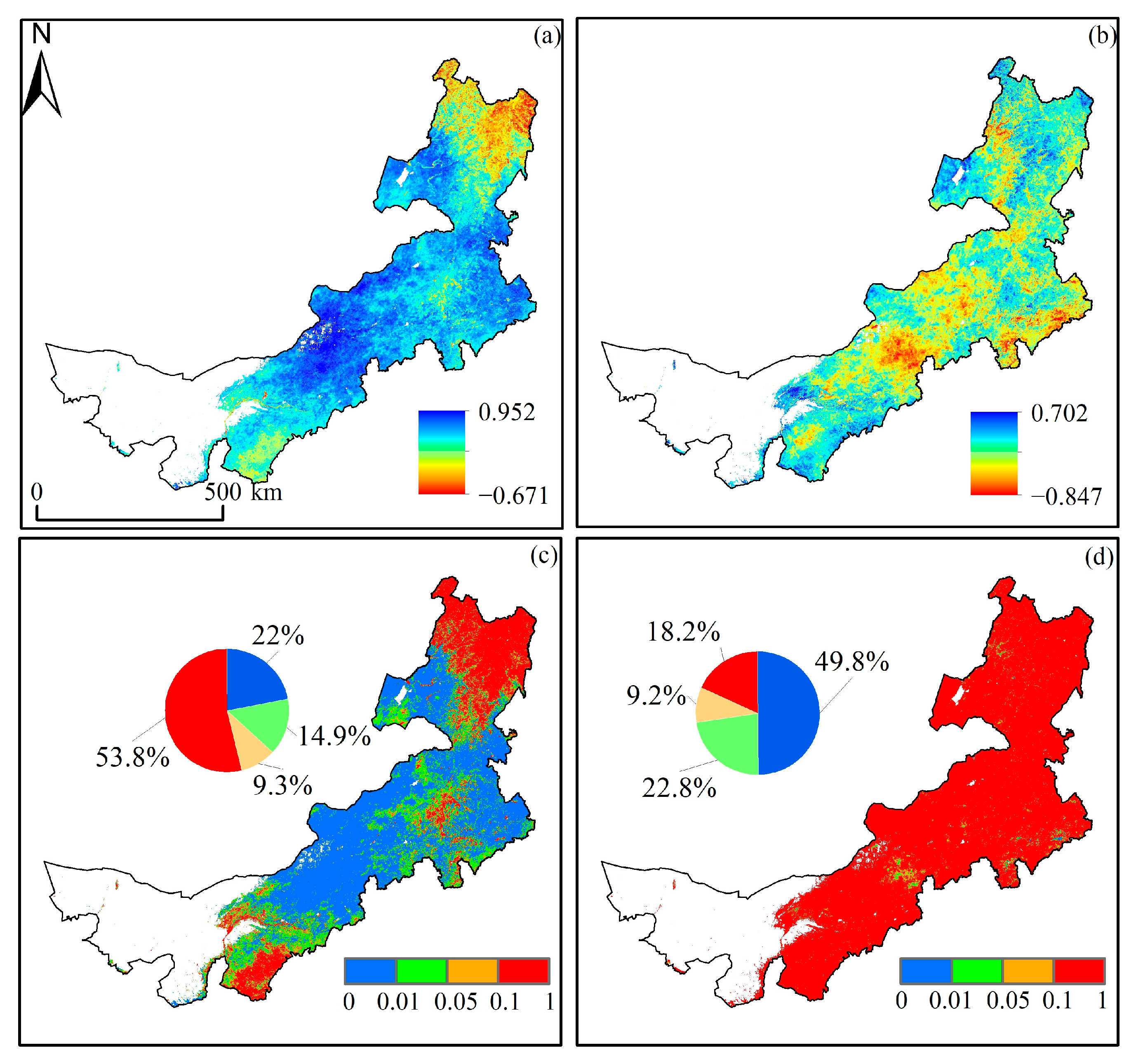
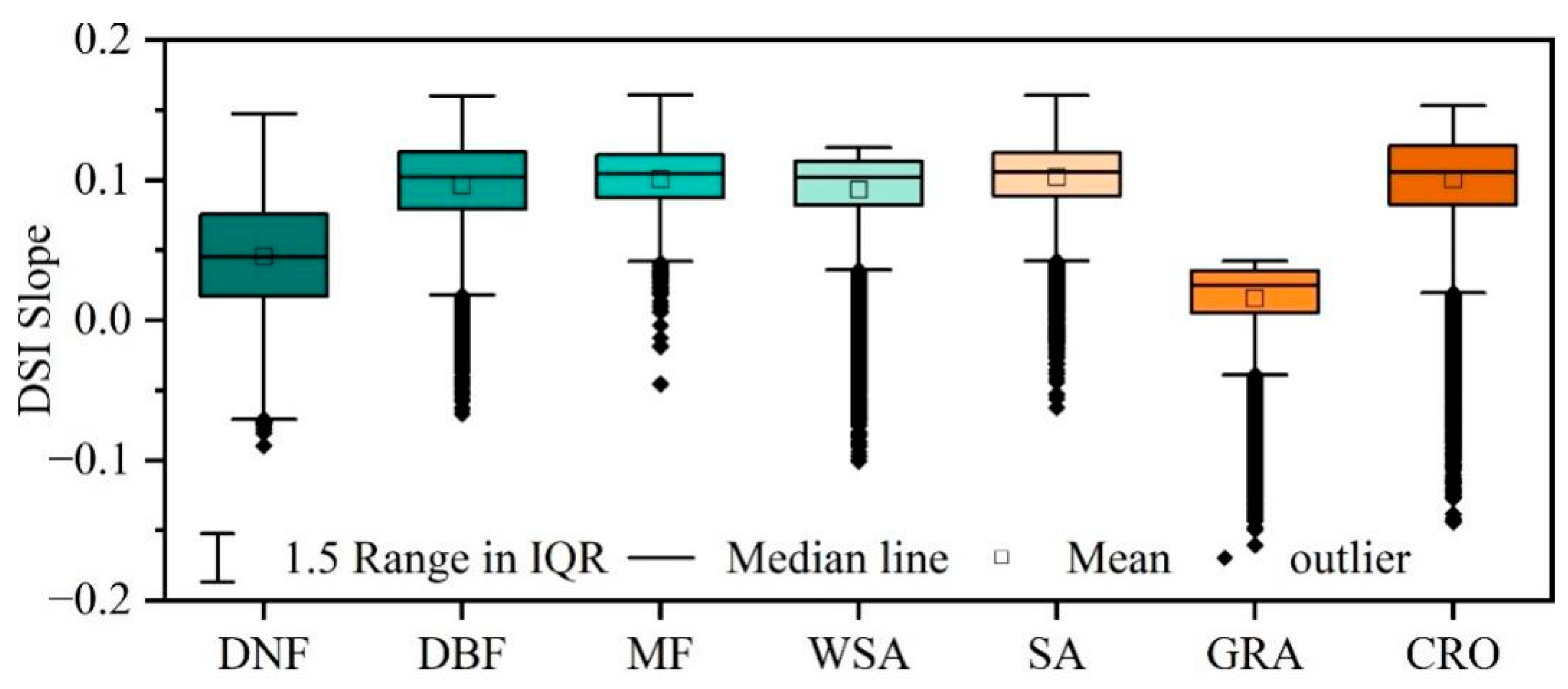
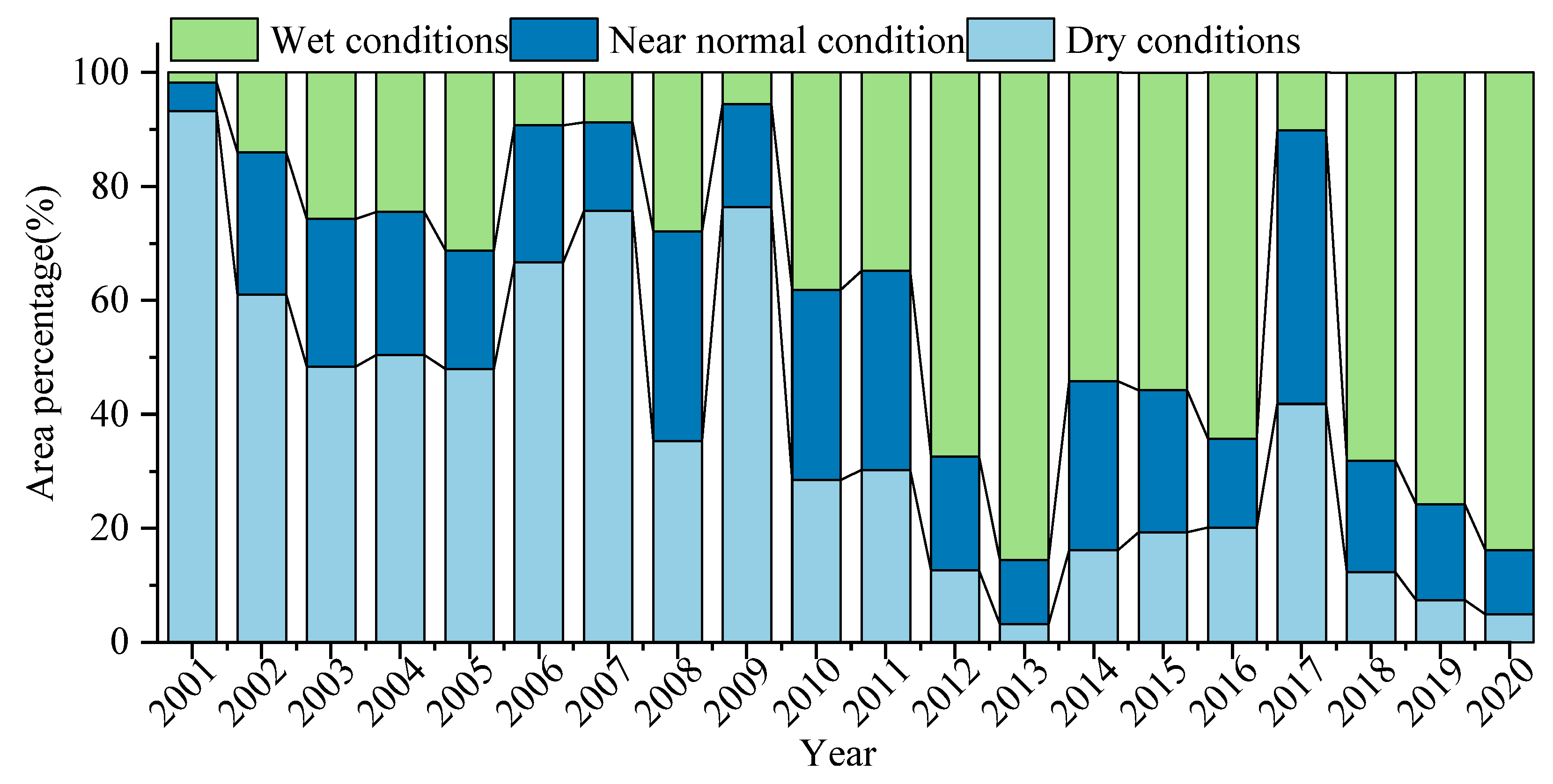
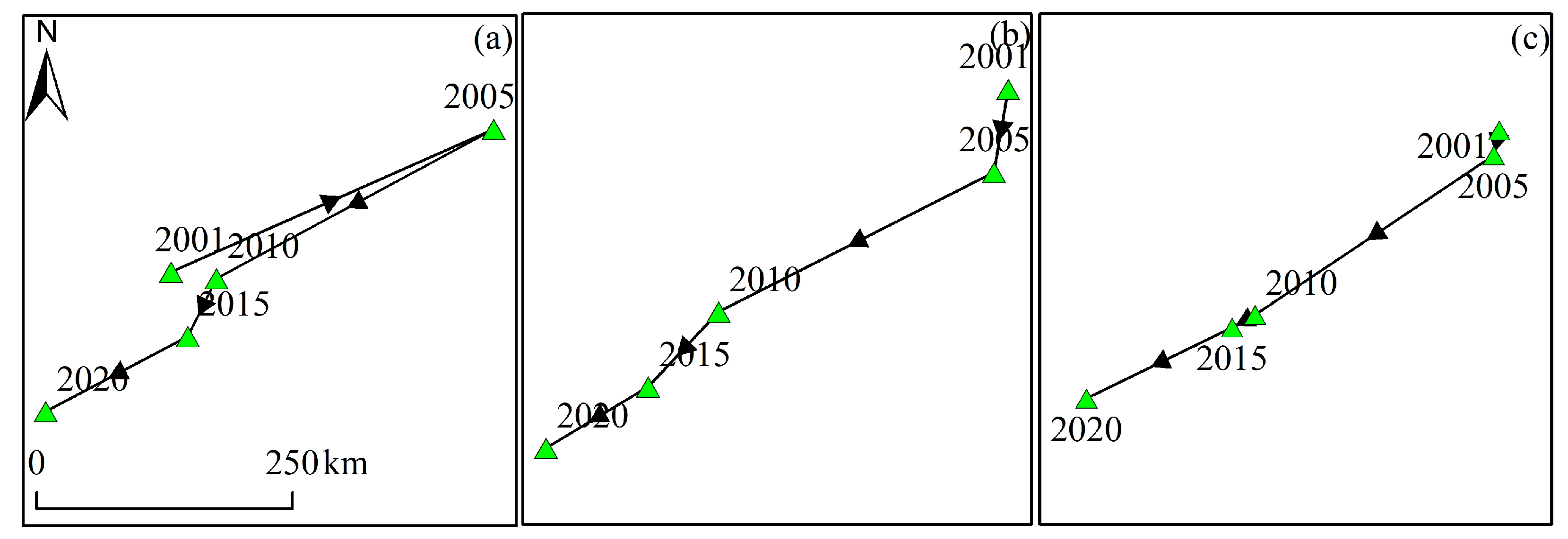
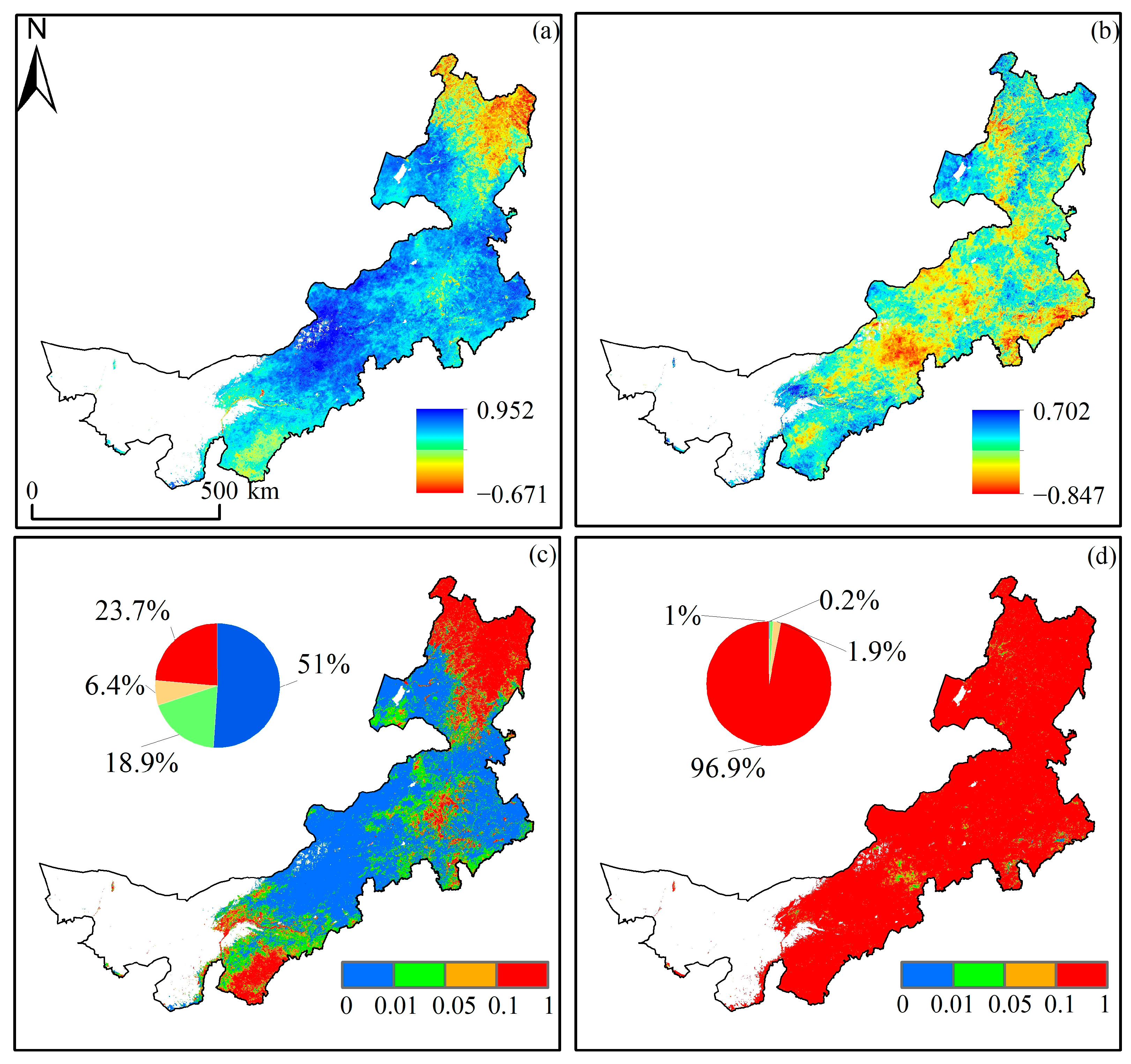
| Category | Grade | DSI |
|---|---|---|
| 1 | Extreme drought | <−1.5 |
| 2 | Severe drought | −1.49 to −1.2 |
| 3 | Moderate drought | −1.19 to −0.9 |
| 4 | Mild drought | −0.89 to −0.6 |
| 5 | Incipient drought | −0.59 to −0.3 |
| 6 | Near normal | −0.29 to 0.29 |
| 7 | Incipient wet | 0.3 to 0.59 |
| 8 | Slightly wet | 0.6 to 0.89 |
| 9 | Moderately wet | 0.9 to 1.19 |
| 10 | Very wet | 1.2 to 1.5 |
| 11 | Extremely wet | >1.5 |
| Type | ET/mm | PET/mm | NDVI | TMP/°C | PRE/mm | Drought Frequency/% |
|---|---|---|---|---|---|---|
| DNF | 362.348 | 749.737 | 0.869 | −3.611 | 453.338 | 0.337 |
| DBF | 482.278 | 921.254 | 0.892 | −1.398 | 455.787 | 0.332 |
| MF | 400.104 | 829.242 | 0.885 | −2.842 | 482.112 | 0.338 |
| WSA | 409.665 | 839.459 | 0.864 | −2.419 | 478.662 | 0.354 |
| SA | 478.252 | 932.348 | 0.868 | −0.355 | 471.404 | 0.358 |
| GRA | 244.104 | 1288.229 | 0.482 | 4.245 | 304.907 | 0.372 |
| CRO | 370.647 | 1149.135 | 0.793 | 3.411 | 403.829 | 0.363 |
| Impact Factors | Temperature | Precipitation | Slope | Elevation | Land Use Type |
|---|---|---|---|---|---|
| Temperature | 0.612 | 0.684 | 0.736 | 0.815 | 0.687 |
| Precipitation | - | 0.273 | 0.398 | 0.573 | 0.463 |
| Slope | - | - | 0.283 | 0.502 | 0.372 |
| Elevation | - | - | - | 0.494 | 0.598 |
| Land use type | - | - | - | - | 0.059 |
Disclaimer/Publisher’s Note: The statements, opinions and data contained in all publications are solely those of the individual author(s) and contributor(s) and not of MDPI and/or the editor(s). MDPI and/or the editor(s) disclaim responsibility for any injury to people or property resulting from any ideas, methods, instructions or products referred to in the content. |
© 2023 by the authors. Licensee MDPI, Basel, Switzerland. This article is an open access article distributed under the terms and conditions of the Creative Commons Attribution (CC BY) license (https://creativecommons.org/licenses/by/4.0/).
Share and Cite
Liu, X.; Wang, S.; Wu, Y. Remote Sensing Identification and the Spatiotemporal Variation of Drought Characteristics in Inner Mongolia, China. Forests 2023, 14, 1679. https://doi.org/10.3390/f14081679
Liu X, Wang S, Wu Y. Remote Sensing Identification and the Spatiotemporal Variation of Drought Characteristics in Inner Mongolia, China. Forests. 2023; 14(8):1679. https://doi.org/10.3390/f14081679
Chicago/Turabian StyleLiu, Xiaomin, Sinan Wang, and Yingjie Wu. 2023. "Remote Sensing Identification and the Spatiotemporal Variation of Drought Characteristics in Inner Mongolia, China" Forests 14, no. 8: 1679. https://doi.org/10.3390/f14081679
APA StyleLiu, X., Wang, S., & Wu, Y. (2023). Remote Sensing Identification and the Spatiotemporal Variation of Drought Characteristics in Inner Mongolia, China. Forests, 14(8), 1679. https://doi.org/10.3390/f14081679





